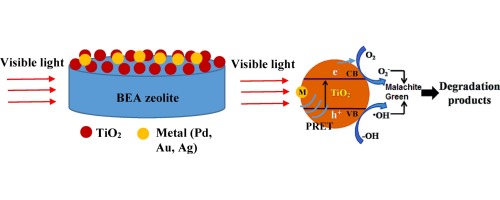Molecular Catalysis ( IF 3.9 ) Pub Date : 2017-09-12 , DOI: 10.1016/j.mcat.2017.08.012 Islam Hamdy Abd El Maksod , Abdelmohsen Al-Shehri , Salem Bawaked , Mohamed Mokhtar , Katabathini Narasimharao

|
The nanosized beta zeolite (BEA) prepared using organic precursors was used to synthesize TiO2-BEA composite by a simple impregnation of titanium isopropoxide (15 wt% TiO2) with uncalcined BEA sample. Then, the Ti-BEA composite was modified with different precious metals (0.25 wt% of Ag, Pd and Au) to obtain photocatalysts, which could work under visible light irradiation. The physico-chemical properties of the synthesized composites were analyzed by powder XRD, FTIR, TEM, DRS UV–vis, XPS and N2-physisorption methods The modification of precious metals reinforced the formation of pure anatase phase. The XRD and TEM results demonstrated that, in combination of BEA and TiO2 retarded the formation of large size crystals of Pd and Ag with a grain size (∼5 nm), however formation of Au nanoparticles in Au modified Ti-BEA composite was observed. The photocatalytic efficiency of the samples was evaluated using malachite green under visible light irradiation. Au modified Ti-BEA sample was found to exhibit higher photocatalytic activity than Pd and Ag modified samples, bare Ti-BEA and Degussa anatase. The observed high photocatalytic activity under visible light is due to the low band gap energy calculated for Au-Ti-BEA sample (2.27 eV) in comparison with 2.54 eV and 3.46 eV for Pd-Ti-BEA and Ag-Ti-BEA samples respectively. Additionally, the presence of relatively big crystalline Au metal particles on the surface to suppress the electron-hole recombination during the reaction. The synthesized composite catalysts can be easily separable and reused for six cycles without losing any photocatalytic activity.
中文翻译:

贵金属改性的TiO 2 -BEA沸石复合材料的结构和光催化性能
使用有机前体制备的纳米级β沸石(BEA)用于通过用未煅烧的BEA样品简单浸渍异丙氧基钛(15 wt%TiO 2)来合成TiO 2 -BEA复合材料。然后,用不同的贵金属(Ag,Pd和Au的重量百分比为0.25)对Ti-BEA复合材料进行改性,以获得可以在可见光照射下工作的光催化剂。通过粉末XRD,FTIR,TEM,DRS UV-vis,XPS和N 2-物理吸附法分析了合成的复合材料的理化性质。贵金属的改性加强了纯锐钛矿相的形成。XRD和TEM结果表明,BEA和TiO 2结合使用阻碍了Pd和Ag晶粒尺寸(〜5 nm)的大尺寸晶体的形成,但是观察到Au修饰的Ti-BEA复合材料中Au纳米颗粒的形成。使用孔雀石绿在可见光照射下评估样品的光催化效率。发现Au修饰的Ti-BEA样品比Pd和Ag修饰的样品,裸露的Ti-BEA和Degussa锐钛矿具有更高的光催化活性。在可见光下观察到的高光催化活性是由于Au-Ti-BEA样品计算出的低带隙能量(2.27 eV),而Pd-Ti-BEA和Ag-Ti-BEA样品分别为2.54 eV和3.46 eV 。另外,在表面上存在较大的结晶Au金属颗粒以抑制反应期间的电子-空穴复合。










































 京公网安备 11010802027423号
京公网安备 11010802027423号